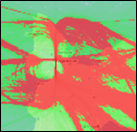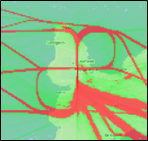The world is focusing more and more on environmental issues. The Paris convention of 2015 set the goals and the world has been working towards them ever since. Isavia has published its environmental policy and is working in accordance with the United Nations (UN) priority targets for the UN Global Compact. Isavia Air Navigation Service (here after ANS) has been working on several improvements to reduce CO2 emissions and decrease fuel burn and noise pollution.
Automatic dependent Surveillance Broadcast
ANS was the first European ANSP to provide Air Traffic Control services to air transport aircraft, based on ADS-B. ANS now provides ATC services using space-based ADS-B and ground-based ADS-B and radars located at multiple sites in Iceland, the Faroe Islands, and Greenland, providing a unified surveillance coverage for the Reykjavik Control Area (CTA). The implementation of ground-based ADS-B in conjunction with direct controller pilot VHF voice communications enabled reduction in separation from 50 NM lateral and 15 minutes longitudinal to 5 NM target to target separation. With this implementation ANS was able to establish a transatlantic surveillance corridor bridging Europe and North America, delivering efficiency, safety, and environmental benefits. In the spring of 2022, the satellite-based ADS-B coverage was expanded to cover the whole of the CTA. In the spring of 2023 BIRD CTA implemented reduced separation from 23 NM lateral and 5 minutes longitudinal to 15 NM ATS Surveillance separation.
Global Navigation Satellite system (GNSS)
Implementing separation procedures based on GNSS (RNAV/RNP) in the low-level airspace where lateral separation was decreased from 30, 50 or 120 NM to as low as 7, 15 or 20 NM has led to significantly better use of airspace where aircraft are more likely to get their optimum flight levels without delays. Fewer aircraft are now restricted to holding for separation purposes. ANS has published PBN Transition Plan where one can see the present status and the planned implementation of RNAV and RNP procedures.
Developments at Keflavík Airport (BIKF):
Arrival manager (AMAN) and time-based arrival manager (TAMAN)
- Amended sequencing procedures using speed restrictions instead of vectoring or holding, supported by AMAN/TAMAN (an addition to the air traffic controller’s surveillance display) has led to more efficient use of airspace.
Performance Based Navigation (PBN)
- Implementing Required Navigation Performance (RNP) Standard Instrument Departures (SID) and Standard Instrument Arrivals (STAR) at Keflavik supported with continuous descent operational. The implementation has led to aircraft being able to descend without stepped descent.
- Implementing RNP approach procedures with lower obstacle clearance altitude (OCA) than for the traditional approach procedures leads to fewer missed approaches due to weather.
Continuous descent arrival (CDA)





